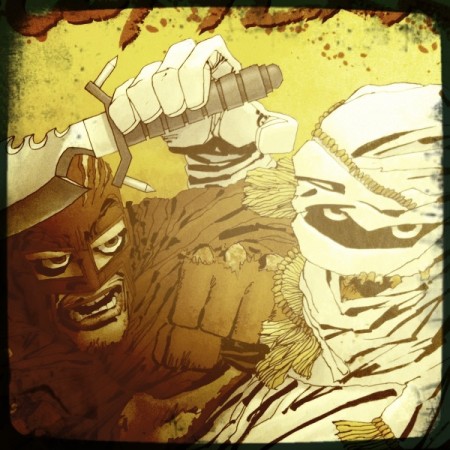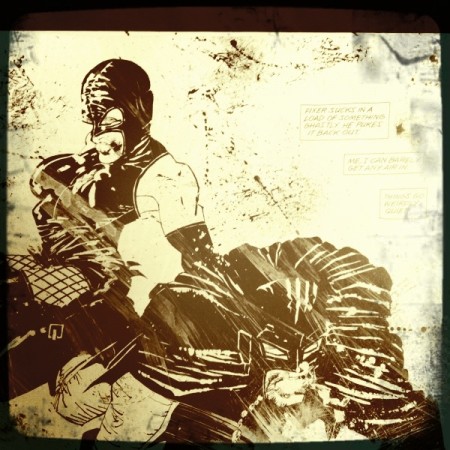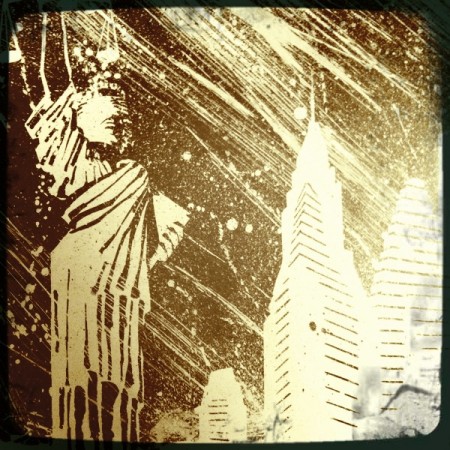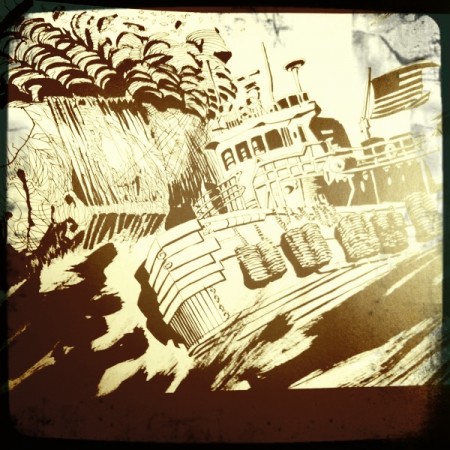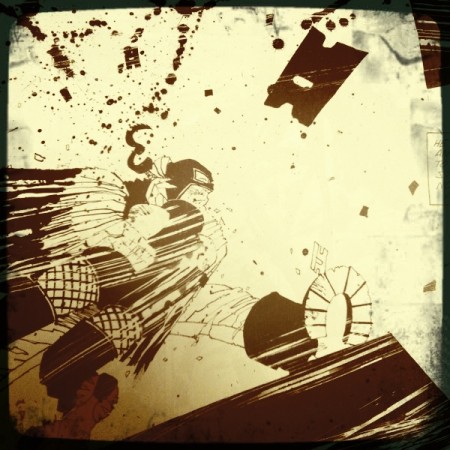Holy Terror! Incendiary. Offensive. Gorgeous.
For the better part of a decade, the comics world has been keeping its eyes on Frank Miller’s Holy Terror. Fans and pundits alike have relentlessly debated the project, needing not even a full page’s glimpse to form an opinion. Which, I suppose, was necessary, seeing as Miller played the hand so close to his chest that news was released only in infrequent snippets.
Occasional whispers of plot. Breathy sighs of editorial tumult. Stifled chuckles of creative insanity.
Lest we not forget that at one time Holy Terror was titled Holy Terror, Batman! The premise was simple: Batman and Catwoman are caught in the midst of a terrorist attack (ala 9/11) and then take it upon themselves to strike back against Al Qaeda. Depending on whose doing the `splaining, Miller’s intention was either to pay homage to classic WWII propaganda comics or simply to vent his anti-Muslim vitriol via the medium he’s helped redefine on multiple occasions.
Of course, DC Comics ain’t in the business of losing business, so Bruce Wayne and Selina Kyle were never given the green light to hunt terrorists. Instead, Miller tells his story by employing The Fixer and the Cat Burglar, analogs probably just different enough to give some peace of mind to the legal department at Legendary Comics (publisher of Holy Terror). So again, it’s The Fixer and Cat Burglar that seek assistance of Dan Donegal (who’s totally not Jim Gordon) to seek revenge.
You might think that Frank Miller prefers using The Fixer so that the Batman purists aren’t offended. But you’d be wrong – dead wrong. In fact, the man’s even said that he hopes this book pisses people off.
Well, yesterday finally saw the release of Holy Terror and I’ve had given it a couple of read-throughs. Now, it’s time to sift through ten years worth of questions posed by both advocates and detractors, to figure out how the story stacks up. Does it trivialize world-issues by painting them in black-and-white terms and solving them with superheroics? Is it artful? Has Frank Miller gone off the deep end? Is it entertaining? Does it fall short of the expectations? Is it worth purchasing?
The answer, to all of the above, is a resounding yes.
Holy Terror is presented in the same style of over-sized pages that helped the 300 collection gain notoriety as an example of sequential art at its finest. As per usual, Miller uses the pages to lay out panels any damn way he sees fit. Although there are more than a few splashes in the book, there are also plenty of pages absolutely teeming with panels. In fact, the last page of a particular notable three-page sequence consists of nearly three hundred blank panels, representing victims of a terrorist attack.
On the more active pages, Miller makes use of his Sin City style – at times he relies heavily on silhouettes and negative space, and at other times frenetic brush strokes fill the entire page. I actually enjoy this approach quite a bit, especially when ink seems to have been spilt across the page just as would blood from a slit wrist. Hell, there’re even a few spots where I’d swear that Frank Miller smudge the images with his bare hands, leaving imprints of his hands and fingers and soul.
Coupled with Dave Stewart’s sparse but tasteful colors, I’d say that Frank Miller’s visual performance in Holy Terror is absolutely stunning. Even if you have issues with the story (don’t worry, we’re getting there), anyone that appreciates comics art will have no problem picking up this book and spending hours gawking at illustrations. If for no other reason, I feel that the artwork justifies the thirty hard earned bucks I’ve shelled out for this book.
However, I’m not quite sure how I feel about Holy Terror as a narrative. While my knee-jerk reaction is to oppose the comic on the philosophical grounds that it is dumbing-down and trivializing some very serious real-world predicaments, I can’t honestly say that I felt this way while reading it. Intellectually, I know that this book could be used by numbskulls and halfwits as some sort of validation of broad-sweeping prejudices. Which sucks. But, if I’m to be honest with myself, I’ve enjoyed plenty of bits of entertainment that play into stereotypes.
For example, 24 was at one time an absolute favorite of mine. And if you don’t think that one of the implicit messages of that show was “Watch out for Muslims, they’re probably terrorists!” then I don’t think you were watching keenly. I mean, Behrooz was a solid dude, but his family was the “average terrorist cell next door” type.
Holy Terror does, in fact, feed into this same type of vigilant paranoia. Consider, for example, Amina, an attractive exchange student whose interactions with a young suitor make her seem completely innocuous. Of course, she is quickly revealed to be one of the suicide bombers responsible for the attack on Empire City. Is it possible that such depictions (either independently or working as a component of a larger narrative-consciousness) could influence a reader to mistrust all Muslims? Yes, most definitely.
Maybe it’s wishful thinking on my part, but I’d like to attach myself to the possibility that those who pick up Holy Terror will take it for worth, engage as active readers, and cultivate political opinions through some other means.
Moreover, my real qualms about Holy Terror‘s narrative structure lay elsewhere, primarily in its length and its underdevelopment. Considering that the book’s production was an effort of years and years and years, I was hoping for something a bit more tome-like. Instead, I breezed through my first reading in just about a half an hour, and I think I gave each page more of a generous gaze than most would. As a Frank Miller fan, I’m always curious to check out what he’s doing — I guess I just wish there was more to check out.
In terms of development, I feel as though the comic comes up short in a couple of areas. Sure, we don’t need too much background information on The Fixer or Cat Burglar – Batman and Catwoman have been around forever, and we all know their deal. But some other threads are never really allowed to ru their course, such as the inclusion of Dan Donegal (the aforementioned Jim Gordon knockoff), who disappears as soon as he’s introduced.
Also abandoned is David, the “most dangerous man alive” who has a Star of David on his fact and provides The Fixer with some crucial information. The setup of David makes the reader think that the character is going to return later to whoop ass, but his appearance is confined to a single page. Again, slightly befuddling.
Overall, I think that Holy Terror is worth taking a peek at. The problem is that Frank Miller is such a divisive figure that this newest released was both venerated and lambasted prematurely. Those that think Miller is off his rocker are going to hater it. Those that think everything he does is gold will love it. The trick, I think, is to go in which as open a mind as possible and then sort out your feelings.
My reaction to the terror? Underwhelming story. Dangerous in the wrong hands. Fucking gorgeous art work.




